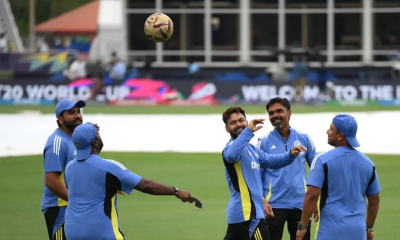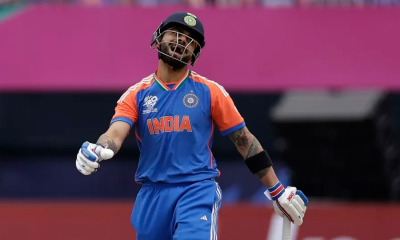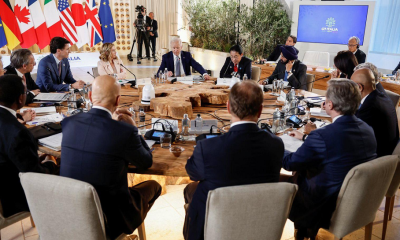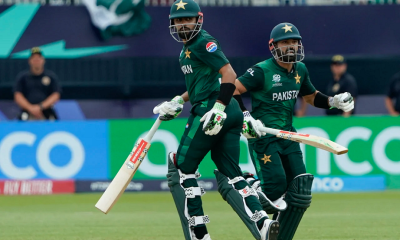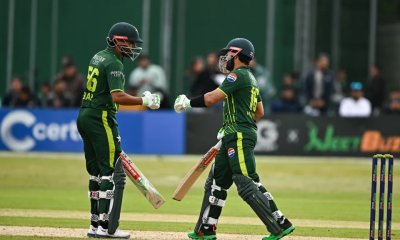News
Canada and JICA joins UNDP to open Mobile Interactive Space on Women’s Empowerment in Jaffna

Chief Representative of the Japan International Cooperation Agency (JICA) in Sri Lanka, Tetsuya Yamada, and Resident Representative of the United Nations Development Programme (UNDP) in Sri Lanka, Azusa Kubota along with Head of Development Cooperation, High Commission of Canada in Sri Lanka, Linda Ehrich visited the Jaffna leg of UNDPs mobile interactive exhibition space, ‘A Journey of Transformation and Women’s Empowerment’. S.M. Saman Bandulasena, Chief Secretary of the Northern Province along with other Government representatives were also present at the inauguration of the exhibition, which is open to the public from the 13th to 15th March at the Jaffna Cultural Centre.
This is the 4th stop as a part of the traveling interactive space, which has now been showcased in Kandy, Kurunegala and Colombo last week, in line with International Women’s Day. Born from an initiative sparked during the 16 Days of Activism campaign last year, the exhibition was also attended by local government and civil society representatives in the area.
This exhibition has evolved into a dynamic platform for social dialogue and empowerment with the support of the Government of Canada and the Royal Norwegian Embassy, celebrating the resilience of Sri Lankan communities supported through UNDP Sri Lanka’s efforts across the years through the support of multiple partners, to address barriers to gender equality and Sexual and Gender-Based Violence (SGBV). This includes featured champion stories from the UNDP led Crisis Response Facility during the socio-economic crisis that brought together private sector and donor partners, including funding from JICA, through which support was provided to enhance food security and rapid medical procurement initiatives.
During the visit to the North, JICA Chief Representative and UNDP Resident Representative also visited other UNDP-led resettlement projects in Palaly and met with beneficiaries of the Japan Supplementary Budget (JSB) funded backyard poultry initiative in Mullaitivu. UNDP’s Resident Representative also made key visits to the Waste to Energy unit at the Vavuniya General Hospital, the Jaffna Public Library, and the Nallur Pradeshiya Sabha to review the efforts and progress of the European Union funded Capacity Development of Local Government (CDLG) project.
JICA has been a longstanding partner of UNDP, especially in the areas of agricultural modernization, climate adaptation and women’s economic empowerment. The field visit aims to further explore common areas of interest and partnership opportunities to serve the people of Sri Lanka.
News
Navy seizes an Indian fishing trawler poaching in Sri Lankan waters north of Talaimannar

During an operation conducted in the wee hours of Tuesday (23 Dec 25), the Sri Lanka Navy seized an Indian fishing trawler and apprehended 12 Indian fishermen, while they were poaching in Sri Lankan waters north of Talaimannar.
Recognizing the detrimental effects of poaching on marine resources and the livelihoods of local fishing communities, the Sri Lanka Navy continues to conduct regular operations as
proactive measures to deter such activities. These efforts underscore the collective robust approach steadfast commitment to safeguarding the nation’s marine ecosystems while ensuring the economic security and wellbeing of its citizens.
The fishing trawler along with the fishermen held in this operation was handed over to the Fisheries Inspector of Mannar for onward legal proceedings.


News
India’s External Affairs Minister meets Sri Lanka PM

India’s External Affairs Minister, Dr. Subramaniam Jaishankar, met with the Prime Minister of Sri Lanka, Dr. Harini Amarasuriya, on 23 December at Temple Trees, during his visit to Sri Lanka as the Special Envoy of Indian Prime Minister Shri Narendra Modi.
The meeting took place as part of the official visit aimed at holding discussions with Sri Lanka’s top leadership, at a time when the nation commenced reconstruction efforts following the devastation caused by Cyclone Ditwah.
During the discussions, the Minister of External Affairs of India reaffirmed readiness to extend support for Sri Lanka, including assistance in rebuilding railways, bridges, and strengthening of the agricultural sector in the country. He also highlighted the importance of having effective systems in place to respond to disaster situations, supported by strong legislative, administrative, and institutional frameworks. Both sides reviewed ongoing relief efforts and explored avenues to further strengthen bilateral cooperation in disaster response and recovery.
The Prime Minister commended the Government of India for the continued support, noting that the recovery process following the devastation caused by Cyclone Ditwah include beyond immediate relief efforts to long-term measures such as resettlement, and reconstruction of habilitation and infrastructure.
The Prime Minister further stated that steps have been taken to reopen schools as part of the process of restoring normalcy, with close monitoring in place. The Prime Minister emphasized the need to ensure stability, reduce vulnerability, and strengthen protection mechanisms highlighting the solidarity of the people, their strong spirit of volunteerism, and collective action demonstrated during the emergency situation.
The event was attended by the High Commissioner of India Santosh Jha, Additional Secretary (IOR), MEA Puneet Agrawal, Joint Secretary (EAMO), MEA Sandeep Kumar Bayyapu, Deputy High Commissioner Dr. Satyanjal Pandey, and representing Sri Lankan delegation, Secretary to the Prime Minister Pradeep Saputhanthri, Additional Secretary to the Prime minister Ms.Sagarika Bogahawatta, Director General (South Asia), Ministry of Foreign Affairs Samantha Pathirana, Deputy Director, South Asia Division, Ministry of Foreign Affairs Ms.Diana Perera.
[Prime minister’s media division]
News
Sri Lanka’s coastline faces unfolding catastrophe: Expert

Sri Lanka is standing on the edge of a coastal catastrophe, with the nation’s lifeline rapidly eroding under the combined assault of climate change, reckless development and weak compliance, Director General of the Department of Coast Conservation and Coastal Resource Management (DCC&CRM) Dr. Terney Pradeep Kumara has warned.
“This is no longer an environmental warning we can afford to ignore. The crisis is already unfolding before our eyes,” Dr. Kumara told The Island, cautioning that the degradation of Sri Lanka’s 1,620-kilometre coastline has reached a point where delayed action could trigger irreversible damage to ecosystems, livelihoods and national security.
He said accelerating coastal erosion, rising sea levels, saltwater intrusion and the collapse of natural barriers, such as coral reefs and mangroves, are placing entire coastal communities at risk. “When mangroves disappear and reefs are destroyed, villages lose their first line of defence. What follows are floods, loss of homes, declining fisheries and forced displacement,” he said.
Dr. Kumara stressed that the coastline is not merely a development frontier but the backbone of Sri Lanka’s economy and cultural identity. “More than half of our tourism assets, fisheries and key infrastructure are concentrated along the coast.
If the coast fails, the economy will feel the shock immediately,” he warned.
Condemning unregulated construction, illegal sand mining and environmentally blind infrastructure projects, he said short-term economic interests are pushing the coastline towards collapse. “We cannot keep fixing one eroding beach while creating three new erosion sites elsewhere. That is not management—it is destruction,” he said, calling for science-driven, ecosystem-based solutions instead of politically convenient quick fixes.
The Director General said the Department is intensifying enforcement and shifting towards integrated coastal zone management, but warned that laws alone will not save the coast. “This is a shared responsibility. Policymakers, developers, local authorities and the public must understand that every illegal structure, every destroyed mangrove, weakens the island’s natural shield,” he added.
With climate change intensifying storms and sea surges, Dr. Kumara warned that Sri Lanka’s vulnerability will only worsen without urgent, coordinated national action. “The sea has shaped this nation’s history and protected it for centuries. If we fail to protect the coast today, we will be remembered as the generation that allowed the island itself to be slowly eaten away,” he went on to say.
By Ifham Nizam
-

 News1 day ago
News1 day agoMembers of Lankan Community in Washington D.C. donates to ‘Rebuilding Sri Lanka’ Flood Relief Fund
-

 News6 days ago
News6 days agoPope fires broadside: ‘The Holy See won’t be a silent bystander to the grave disparities, injustices, and fundamental human rights violations’
-

 News6 days ago
News6 days agoPakistan hands over 200 tonnes of humanitarian aid to Lanka
-

 Business5 days ago
Business5 days agoUnlocking Sri Lanka’s hidden wealth: A $2 billion mineral opportunity awaits
-

 News5 days ago
News5 days agoArmy engineers set up new Nayaru emergency bridge
-

 News6 days ago
News6 days agoOfficials of NMRA, SPC, and Health Minister under pressure to resign as drug safety concerns mount
-

 News6 days ago
News6 days agoExpert: Lanka destroying its own food security by depending on imported seeds, chemical-intensive agriculture
-

 Editorial6 days ago
Editorial6 days agoFlawed drug regulation endangers lives


